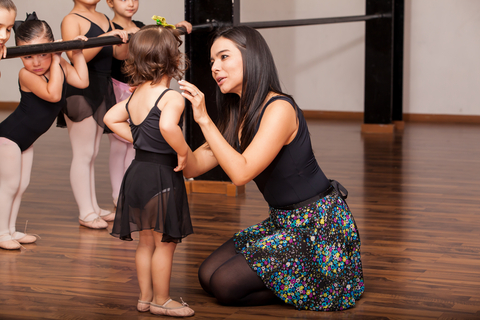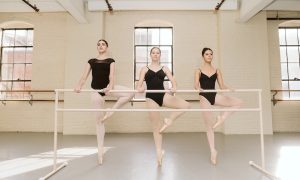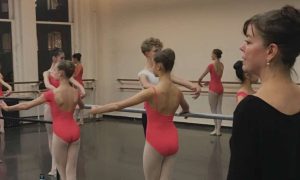By Emily Yewell Volin of Dance Informa.
Faculty
A studio is only as good as its instructors and different classes require a different type of instructor for optimum benefit. While professional performance experiences with reputable companies are frequently a guarantee of technical ability on the teacher’s behalf, the same doesn’t always translate to top-quality instruction. Find out where current and former students of the studio are and what they are doing. The goal is for your young dancer to find a place with excellent technical training alongside a passion for embracing youth development. This partnership of purpose helps young dancers generalize lessons from dance study to inform their future endeavors. Pay attention to the variety of teachers employed by the school – the more diverse, the better.
Class Offerings
What type(s) of dance does your child hope to study? Find out what genres the school offers. Options include, but are in no way limited to, classical ballet, creative movement, jazz, contemporary, modern, tap, world dance, hip-hop, social dance, leaps and turns, and stretch. Ask the school for class definitions and then compare what your child seems interested in with the options.
Communication
Find out how the studio communicates with its students and their families. Does the school utilize a website or social media to keep families informed of news, weather-related closings and general announcements? What are the payment options for classes? Are discounts offered to those who pay for a half-year or a full year instead of monthly? Can you pay online or set up an auto payment? And on which day of the month will tuition be due? Notice if audition postings, summer study fliers and dance-related news, health and tips articles are available to students. A vibrant studio will have a constant influx of current news and information available for students and their families.
Student Placement & Progress Reports
Ask how the school will properly place your child into class. Is there a placement audition or will the child be asked to sample a few classes and decide, upon consultation with faculty, where he/she best fits? How will your student receive feedback about goal-setting and accomplishment? Is there a system in place for student reflection about his/her progress? Also, find out if/when parents are welcome to observe class. Most schools designate a parent watch week and a few schools offer one-way mirrors or live video feed from the studio to the lobby for interested parents. Know that it is important for your student to be able to do his/her class work without constant parental input, but that it is important for a parent to be aware of his/her child’s work ethic and progress.
Conservatory, Competitive or Recreational
Deciding what type of school or class is best for your child can be tricky. Is your child drawn to dance because of a particular exposure to movement? Does your child enjoy performance and/or competition or want to dance recreationally? These are questions to ask your aspiring dancer. Most studios offer a few different tracks for dancers. You can register for once weekly recreational classes that may or may not include a performance component – typically a recital or informal event. However, if your dancer hopes to be involved in large-scale productions and commit to a conservatory-type of training in various genres for several hours a week, you may want to audition for placement in the studio’s youth company. Finally, some studios offer a competitive option. These schools typically offer the opportunity to audition for inclusion on a traveling competitive team.
Dress Code
What type(s) of dress codes are in place at the studio you are considering? The answer to this will inform your knowledge of the studio’s approach. You hope to find that the school requires form-fitting clothing as well as appropriate footwear, no jewelry and hair secured off the face. Dress codes for a recreational class will be less formal than for the conservatory or competitive classes. However, it is typical for a youth company format to involve a celebrated succession of color leotards that denote accomplishment of level. For example, the youngest dancers begin in ballet pink, the eldest and most accomplished dancers graduate to navy blue. Instructors must be able to see body alignment in order to provide essential body alignment information. Dress codes also ensure appropriate coverage and support of the body during class.
Facility
Visit the school and assess its cleanliness, safety of the entrance and parking lot and studio arrangement. Find out if there are student dressing rooms, accessibility to water and adequate lighting. Is the studio atmosphere vibrant and are materials (mats, barres, floors) in good condition? Ask about the flooring system in the studios and be certain your dancer will not be dancing on concrete. The gold standard for studio flooring is a floating floor covered with marley. Find out what your dancer’s developing body will be spending hours training upon.
Camaraderie
Plan a time to visit the school with your aspiring student. Aim for arriving during the bustle of classes and, without causing disruption, peek into the classroom windows to get a sense of how classes are conducted at the school. Are the classes conducted in an orderly way? Pay attention to the rapport among studio faculty, students, parents and staff. Do people seem happy to be there and at ease? Do you see evidence of individual and group accomplishments being celebrated by the studio’s community via a newsletter or bulletin board postings in the studio? What types(s) of programs are in place for helping dancers at the studio feel part of the larger studio community? Big Sister/Big Brother programs between the older and younger dancers, open studio days, flash mob participation, fundraising activities and other recreational events help students and their families find the benefits of authentic community through the studio.
Performance Component
Does the idea of performing excite or terrify your child? Find out which class, company or competitive expectations best fit your student’s interests and register accordingly. Ask about the rehearsal time, financial commitment and volunteer expectations involved with the different options. Be realistic about discerning the best balance for your family.
Performance Samples
View performance samples from the studio. Many schools share these samples online. If not, ask for access to a recent recording. As you are watching, assess the age appropriateness of the choreography and costuming as well as the overall quality of the performance. Regardless of the technical ability of the dancer(s), the performance should look well rehearsed and polished.
Photo (top): © Antoniodiaz | Dreamstime.com













